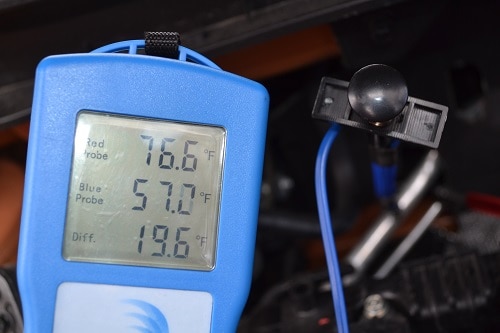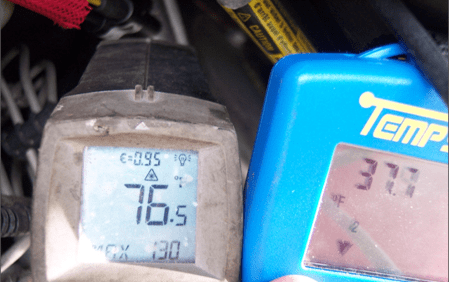Temperature testing accuracy
By Richard Hawkins, MACS Contributor
MACS held an on-line Mobile A/C Update Clinic on March 30,2021 and one of the topics addressed was temperature testing. In this class, the importance of obtaining accurate temperature readings was stressed so this seems like a good time to write on that subject.

Temperature testing adds an extra dimension to diagnostics.
Temperature testing can be used to determine if a component might have a restriction in it. It can also be used to determine if an orifice tube system might be undercharged and it can be used to charge an orifice tube system. But if the readings are not accurate, all they are going to do is cause you problems. How do we ensure that we are getting accurate temperature readings? The short answer to that is to use the correct temperature reading tool (a contact type thermometer). Please read on as we illustrate.
As the MACS A/C Update Clinic mentioned, INFRARED temperature reading devices just do not have the accuracy necessary to do A/C diagnostics (especially reading temperatures on the low side lines). They have their place in a shop when it comes to checking components with high temperatures. Examples would be checking temperatures on catalytic converters or checking temperatures on an exhaust manifold or header to locate a misfiring or lean running cylinder.
Accuracy is the issue.
Using an infrared thermometer for air conditioning diagnostics can lead to problems. As an example, please refer to the picture below. It shows an infrared thermometer and a contact type thermometer. There are both reading the temperature on a suction line in an area within an inch of each other. As you can see, the contact type thermometer shows 37.7 ° F while the infrared gun shows 76.5° F. That is a whopping 38.8° difference.

This was not a situation where this gun was carelessly aimed to get that reading. It was carefully aimed to get the lowest reading. It also was not a defective gun. I have done this test numerous times with different guns and readings that are about 20° to 40° off are typical. Even if it had been off by only 5° or 6°, that is still too much.
One might ask; well how do you know the contact type thermometer was reading accurately and the infrared gun was the one that was wrong? The answer to that is, I do not know for sure that the suction line was 37.7°, but with condensation dripping from it and the temperature of it feeling like a cold glass of iced tea to the touch, it was a lot closer to 37.7° than 76.5°.
Contact type thermometers are very accurate temperature reading devices, but there are precautions that need to be taken with them to ensure that the readings we are seeing with them are accurate. Check back in next week and we will explore those precautions.
If you like the content you see here, there’s so much more available when you become a member of MACS. Join us today!

Leave a Reply